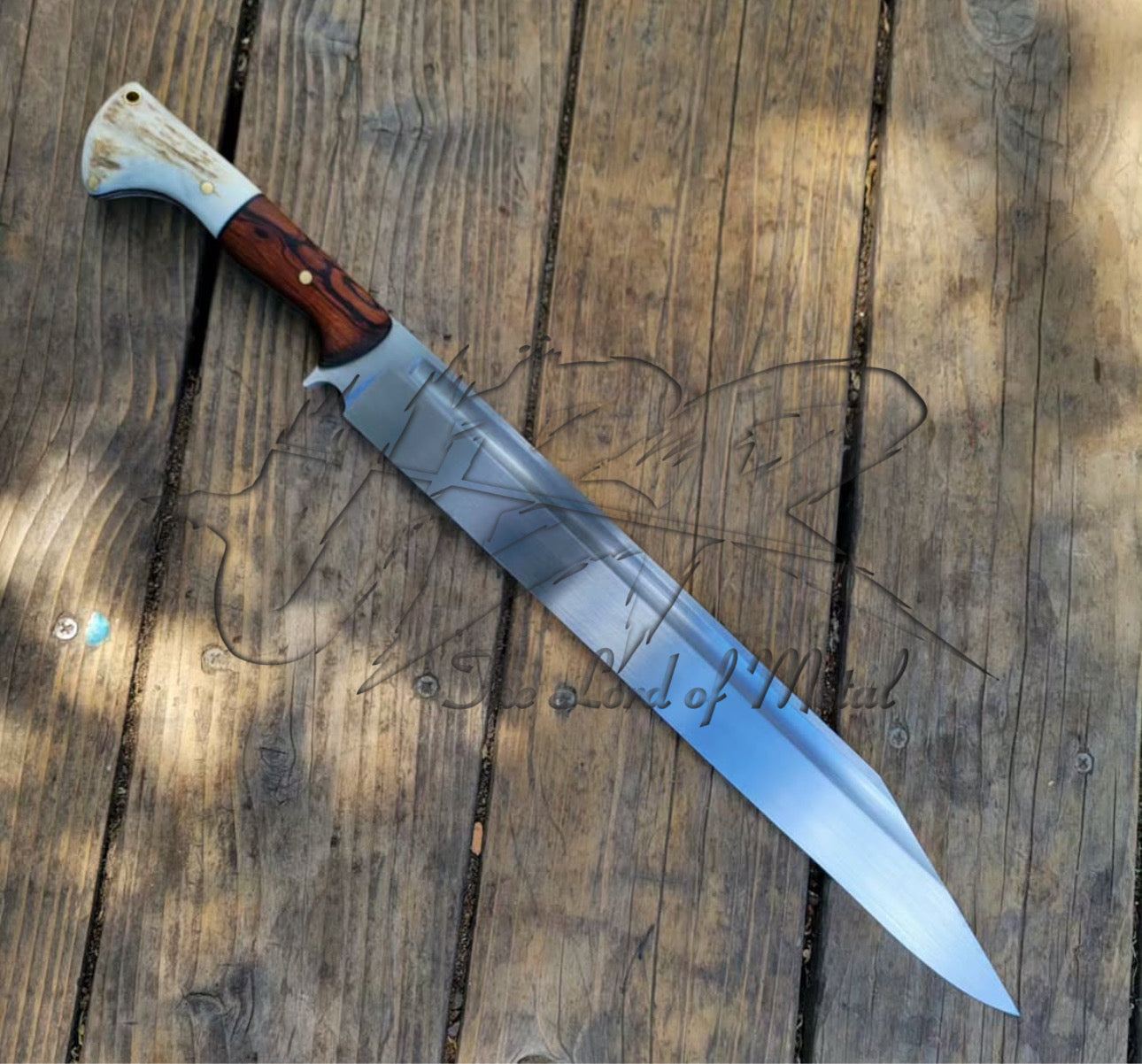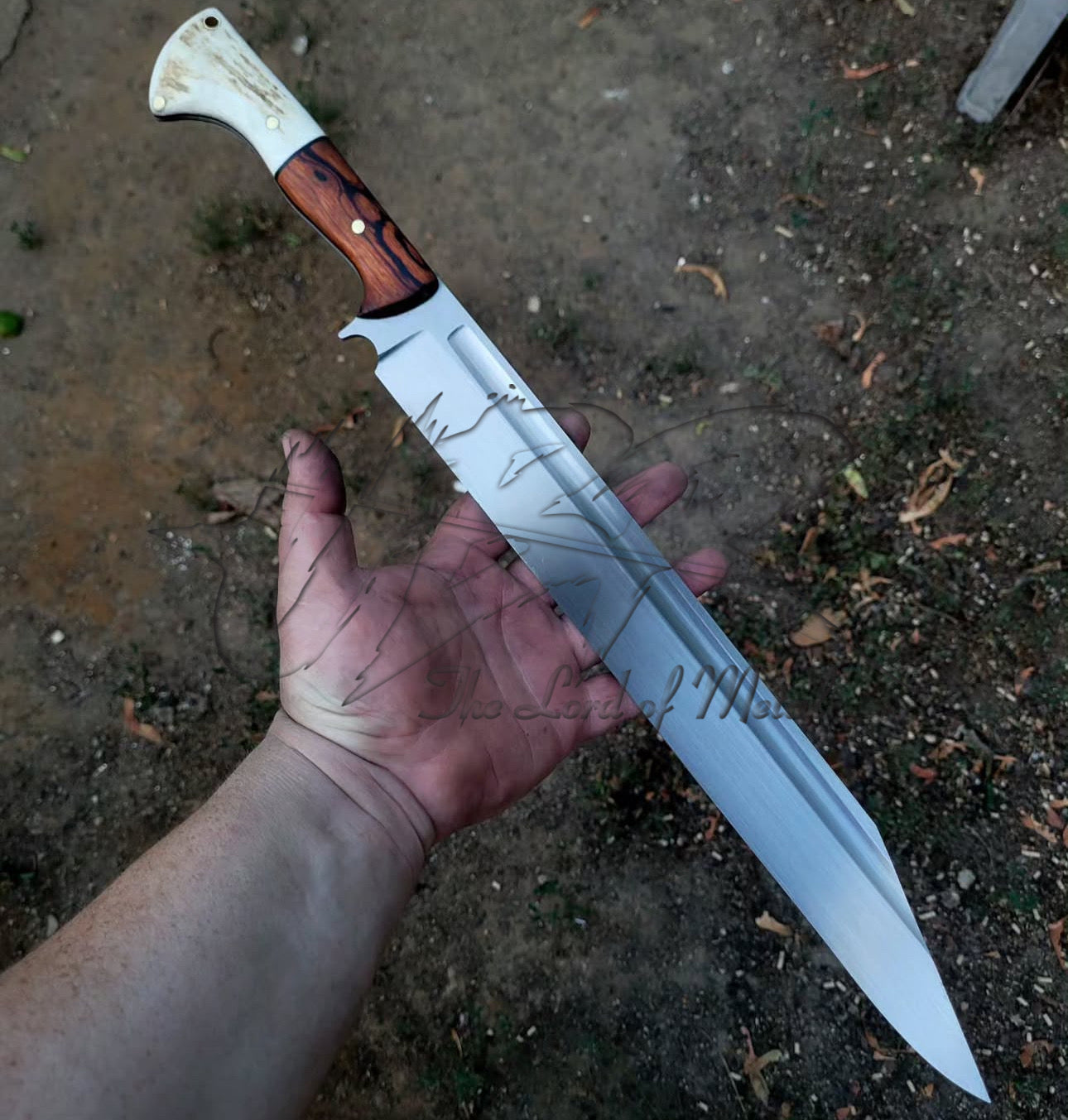Unique Blades Runner
Custom Handmade D2 Steel Seax Sword with Stag Horn & Rosewood Handle
Custom Handmade D2 Steel Seax Sword with Stag Horn & Rosewood Handle
🔁 14-day returns · View policy
Couldn't load pickup availability
Personalization Info
Personalization Info
🎨 Make Your Blade Truly Unique
We offer custom engraving on many of our handmade knives, swords, and daggers. Whether it’s a name, initials, logo, or symbol — we use a high-precision 50W fiber laser to mark your item with sharp, lasting detail.
✨ How to Personalize Your Order:
- 📧 Send your engraving details to uniquebladesrunner@gmail.com
- 🖋️ Include text or artwork (initials, name, or small graphic)
- ✅ We’ll confirm if engraving is available for your chosen product
🕒 Please note: Personalized items may take extra processing time and are not eligible for return.
Have questions? Feel free to reach out before placing your order — we’re happy to help!
Custom Orders
Custom Orders
🛠️ Custom Orders Welcome
Looking for something unique? We offer fully custom-made knives, swords, and collectibles designed to your exact preferences. Whether it’s for display, gifting, or your personal collection — we’re here to bring your idea to life.
✨ Custom Options Include:
- Blade length and style
- Handle material (wood, bone, stag, etc.)
- Steel type (Damascus, high carbon, D2, 1095, 5160, 80CrV2, stainless, or custom on request)
- Engraving or decorative finishes
📩 Reach out at uniquebladesrunner@gmail.com with your design idea or reference image. We’ll reply with availability, pricing, and estimated delivery time.
Care Instructions
Care Instructions
Your handmade blade deserves proper care to last a lifetime. Follow these tips to preserve its beauty and performance:
🔪 General Care:
- Keep the blade clean and dry after use
- Apply a thin coat of oil (mineral, camellia, or gun oil) regularly
- Avoid prolonged exposure to water or moisture
🔥 Damascus & High Carbon Steel:
- These steels are not stainless — they require extra care
- Store in a cool, dry place with low humidity
- Wipe with an oiled cloth before storing
🧊 Stainless Steel Blades:
- More resistant to rust, but still benefit from proper care
- Clean with a soft cloth and mild soap — dry immediately
- Light oiling helps preserve the finish and smoothness
Never place your blade in a dishwasher or soak it in water. Proper care ensures long-term durability and appearance.
Shipping Information
Shipping Information
🚚 Shipping Information
We ship worldwide with reliable tracking and protective packaging to ensure your blade arrives safely.
📦 Processing Time:
- Standard items: Ships in 4–7 business days
- Custom orders: Varies based on design complexity
✈️ Estimated Delivery:
- Domestic: 5–7 business days
- International: 10–20+ days (depending on customs)
🌍 Customs & Duties:
- International buyers are responsible for any applicable import taxes or customs fees
You’ll receive tracking info once your order is shipped. Have questions about shipping times? Email us anytime.
Disclaimer
Disclaimer
All our blades are individually handcrafted — no two items are exactly alike. Slight variations in grain, polish, or dimensions are part of the artistry.
- Our products are intended for collectors, chefs, and outdoor users
- Not designed for harm or misuse of any kind
- Must be used responsibly and in accordance with local laws
By purchasing, you acknowledge understanding and acceptance of our terms.


Seax Sword – A Timeless Blade of Anglo-Saxon Heritage
The Seax Sword is one of history’s most recognizable and culturally significant blades, celebrated for its unique design, practicality, and role in the daily life of early medieval Europe. Originating among the Anglo-Saxons, Vikings, and other Germanic tribes, the Seax was more than just a tool—it was a symbol of identity, craftsmanship, and heritage. Today, collectors and enthusiasts value it for its distinctive shape, rich history, and aesthetic appeal.
From historical reenactments to display collections, the Seax Sword continues to capture the imagination of history lovers and artisans alike. Whether you’re a collector looking to preserve history or someone who admires the artistry of forged steel, the Seax remains a centerpiece of early medieval culture.
Historical Significance of the Seax Sword
The Seax Sword dates back to the Migration Period and early Middle Ages, often associated with the Saxons—so much so that their name is believed to derive from this very blade. Unlike many long swords of the period, the Seax featured a single-edged blade with a straight or slightly curved profile, making it versatile for both daily use and ceremonial purposes.
Archaeological finds, such as the famous Beagnoth Seax discovered in the River Thames, reveal intricate engravings, inscriptions, and decorative patterns that show the blade was not only functional but also a treasured possession. The Seax became a mark of cultural identity, with variations seen in both Viking-age Scandinavia and Anglo-Saxon England.
Design Features That Make the Seax Sword Unique
Collectors appreciate the Seax Sword for its instantly recognizable profile. Unlike double-edged swords, its single edge allowed for a stronger spine, making the blade durable and practical. The blade length could vary greatly, from smaller utility-sized seaxes to longer “long seaxes” that reached the size of short swords.
A Wide blade with a straight or slightly slanted tip, enhancing its cutting strength
B Single-edged design with a reinforced spine for durability
C Traditional wood, bone, or antler handles, often adorned with decorative carvings
Modern artisans often recreate the Seax Sword using historical forging techniques, combining high carbon steel or Damascus steel patterns for added beauty. Many choose to preserve its traditional form, while others incorporate contemporary materials for improved durability.
Cultural and Pop Culture Influence
The Seax Sword has made appearances in numerous films, series, and games centered on Viking and Anglo-Saxon themes. Shows like The Last Kingdom and Vikings have brought renewed interest to this iconic blade, making it a favorite among reenactors and collectors inspired by historical dramas. Its straightforward yet commanding appearance makes it stand out in any display or historical costume setting.
Why Collectors Value the Seax Sword
The enduring appeal of the Seax Sword lies in its ability to bridge the gap between historical authenticity and visual artistry. Whether displayed in a collection, worn for living history events, or showcased in a themed interior, the Seax adds an unmistakable historical charm.
A Symbol of heritage for enthusiasts of Anglo-Saxon and Viking culture
B Crafted with attention to authentic historical proportions and detailing
C A statement piece for display, reenactment, and cultural exhibitions
Modern Craftsmanship and Materials
Today’s blacksmiths and bladesmiths create the Seax Sword using a blend of traditional forging and modern enhancements. Damascus steel is a popular choice for its striking layered patterns, while high carbon steel ensures sharpness and strength. Handles are often made from walnut, oak, stag horn, or micarta, giving each piece a unique personality.
Authentic Replication – Many artisans reference archaeological finds to ensure their Seax Sword replicas match historical dimensions and aesthetics.
Durability – With modern metallurgy, these swords are more resistant to wear while maintaining their traditional look.
Detail Work – Engravings, runes, and pattern welding techniques enhance the sword’s authenticity and appeal.
Historical Care and Maintenance
In history, the Seax Sword was cared for diligently, often kept in a leather sheath and oiled to prevent rust. For collectors today, similar care ensures longevity and preserves the blade’s beauty.
A Store in a cool, dry environment away from moisture
B Apply light oil to the blade periodically to prevent oxidation
C Avoid prolonged contact with acidic substances to protect the steel finish
Seax Sword in Modern Reenactments
Living history events and reenactment groups frequently incorporate the Seax Sword into their costumes and displays. It pairs naturally with shields, tunics, and other early medieval attire, making it a versatile piece for both authenticity and showmanship.
Buying a Seax Sword – What to Look For
When selecting a Seax Sword, pay attention to both the craftsmanship and the authenticity of the design.
A Steel Quality – High carbon or Damascus steel provides strength and aesthetic appeal
B Handle Material – Natural materials like wood, antler, or bone give a traditional feel
C Balance and Weight – Well-balanced for realistic handling and display
Conclusion – The Legacy Lives On
The Seax Sword is more than a collectible—it is a piece of living history. From the battlefields and farms of early medieval Europe to the collections and walls of today’s enthusiasts, it continues to inspire admiration for its craftsmanship, cultural identity, and enduring beauty.
FAQ
Q: What is the historical origin of the Seax Sword?
The Seax Sword originated among the Anglo-Saxons and other Germanic tribes during the early Middle Ages and was used for both utility and ceremonial purposes.
Q: Is the Seax Sword the same as a Viking sword?
No, the Seax Sword is typically single-edged and shorter, while Viking swords are usually double-edged and longer.
Q: What materials are traditionally used in making a Seax Sword?
Historically, they were forged from high carbon steel with handles made from wood, bone, or antler.
Q: Why is the Seax Sword popular in reenactments?
Its cultural significance and historical accuracy make it an essential piece for Anglo-Saxon and Viking reenactment groups.
Q: Can a Seax Sword be made with modern materials?
Yes, modern artisans often use Damascus steel, micarta, and stabilized woods to create durable and visually striking versions.


